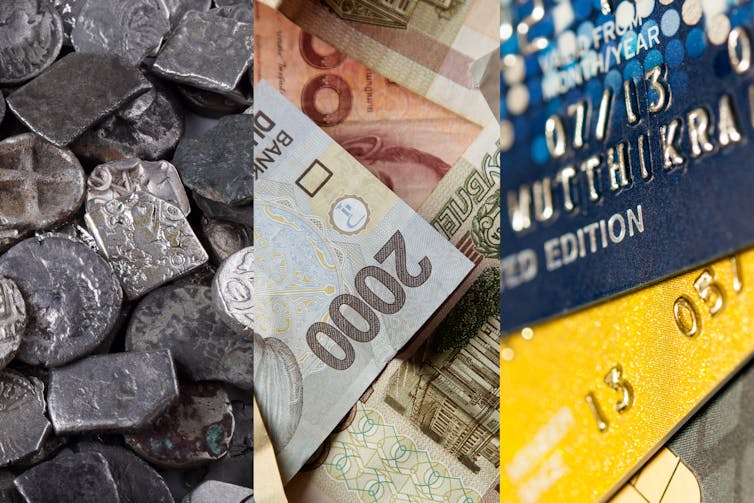
Alex Coan/MD_Photography/Ti_ser, Shutterstock.com
Mary Mellor, Northumbria University, Newcastle
There is nothing natural about money. There is no link to some scarce essential form of money that sets a limit to its creation. It can be composed of base metal, paper or electronic data – none of which is in short supply. Similarly – despite what you may have heard about the need for austerity and a lack of certain cash-generating trees – there is no “natural” level of public expenditure. The size and reach of the public sector is a matter of political choice.
Which puts austerity, the culling of expenditure in the public economy, under some question. For some countries, such as Greece, the impact of austerity has been devastating. Austerity policies still persist despite numerous studies arguing that they were entirely misconceived, based on political choice rather than economic logic. But the economic case for austerity is equally mistaken: it is based on what can best be described as fairytale economics.
So what were the justifications? Britain, for example, has lived under an austerity regime since 2010, when the incoming Tory-Liberal Democrat government reversed the Labour policy of raising the level of public expenditure in response to the 2007-8 financial crisis. The crisis had created a perfect storm: bank rescue required high levels of public spending while economic contraction reduced tax income. The case for austerity was that the higher level of public expenditure could not be afforded by the taxpayer. This was supported by “handbag economics”, which adopts the analogy of states as being like households, dependent on a (private sector) breadwinner.
This article is part of Conversation Insights
The Conversation’s Insights team generates long-form journalism derived from interdisciplinary research. The team is working with academics from different backgrounds who have been engaged in projects aimed at tackling societal and scientific challenges. In generating these narratives we hope to bring areas of interdisciplinary research to a wider audience.
You can read more Insights stories here.
Under handbag economics, states are required to restrict their expenditure to what the taxpayer is deemed to be able to afford. States must not try to increase their spending by borrowing from the (private) financial sector or by “printing money” (although the banks were rescued by doing so by another name – quantitative easing, the creation of electronic money).
The ideology of handbag economics claims that money is to be generated only through market activity and that it is always in short supply. Request for increased public expenditure is almost invariably met with the response “where’s the money to come from?” When confronted by low pay in the NHS, the British prime minister, Theresa May, famously declared, “there is no magic money tree”.
So where does money come from? And what is money anyway?
What is money?
Until the last 50 years or so the answer seemed to be obvious: money was represented by cash (notes and coin). When money was tangible, there seemed no question about its origin, or its value. Coins were minted, banknotes were printed. Both were authorised by governments or central banks. But what is money today? In richer economies the use of cash is declining rapidly. Most monetary transactions are based on transfers between accounts: no physical money is involved.
In the run up to the financial crisis, the state’s role in relation to money held in bank accounts was ambiguous. Banking was a monitored and licensed activity with some level of state guarantee of bank deposits, but the actual act of creating bank accounts was, and is, seen as a private matter. There may be regulations and limitations, but there is no detailed scrutiny of bank accounts and bank lending.
Yet, as the 2007-8 financial crisis showed, when bank accounts came under threat as banks teetered on the edge of bankruptcy, states and central banks had to step in and guarantee the security of all deposit accounts. The viability of money in non-investment bank accounts was demonstrated to be as much a public responsibility as cash.
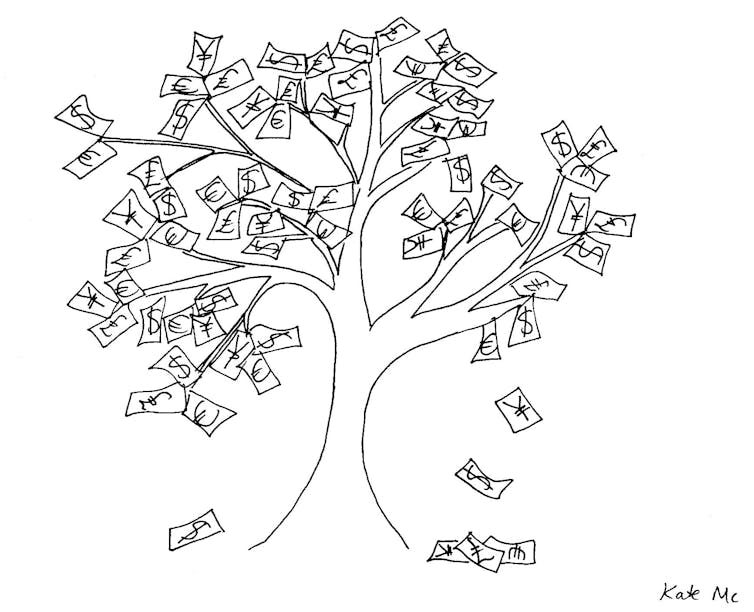
The magic money tree.
© Kate Mc, Author provided
This raises fundamental questions about money as a social institution. Is it right that money can be generated by a private choice to take on debt, which then becomes a liability of the state to guarantee in a crisis?
But far from seeing money as a public resource, under neoliberal handbag economics, money creation and circulation has increasingly been seen as a function of the market. Money is “made” solely in the private sector. Public spending is seen as a drain on that money, justifying austerity to make the public sector as small as possible.
This stance, however, is based on a complete misunderstanding of the nature of money, sustained by a series of deeply embedded myths.
Myths about money
Neoliberal handbag economics is derived from two key myths about the origin and nature of money. The first is that money emerged from a previous market economy based on barter. The second is that money was originally made from precious metal.
It is claimed that bartering proved to be very inefficient as each buyer-seller needed to find another person who exactly matched their requirements. A hat maker might barter a hat for some shoes she needs – but what if the shoe maker is in no need of a hat? The solution to this problem, so the story goes, was to choose one commodity that everyone desired, to act as a medium of exchange. Precious metal (gold and silver) was the obvious choice because it had its own value and could be easily divided and carried. This view of the origin of money goes back to at least the 18th century: the time of economist Adam Smith.
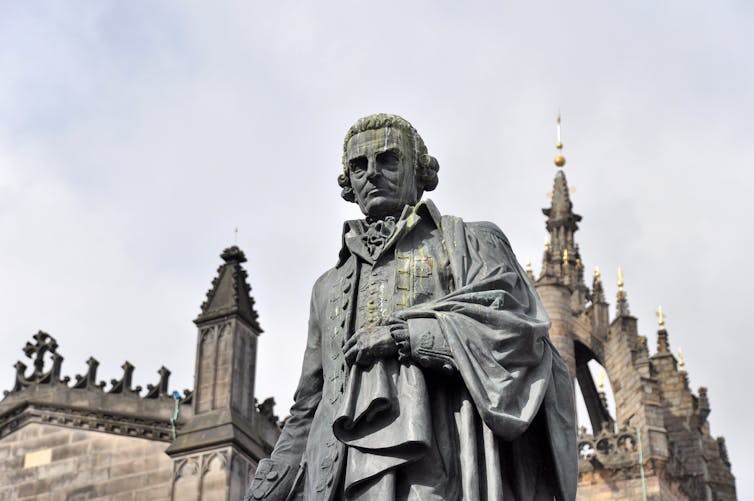
The ‘father of capitalism’ Adam Smith, 1723-1790.
Matt Ledwinka/Shutterstock.com
These myths led to two assumptions about money that are still current today. First, that money is essentially connected to, and generated by, the marketplace. Second that modern money, like its original and ideal form, is always in short supply. Hence the neoliberal claim that public spending is a drain on the wealth-creating capacity of the market and that public spending must always be as limited as possible. Money is seen as a commercial instrument, serving a basic, market, technical, transactional function with no social or political force.
But the real story of money is very different. Evidence from anthropology and history shows that there was no widespread barter before markets based on money developed, and precious metal coinage emerged long before market economies. There are also many forms of money other than precious metal coins.
Money as custom
Something that acts as money has existed in most, if not all, human societies. Stones, shells, beads, cloths, brass rods and many other forms have been the means of comparing and acknowledging comparative value. But this was rarely used in a market context. Most early human communities lived directly off the land – hunting, fishing, gathering and gardening. The customary money in such communities was used mainly to celebrate auspicious social events or serve as a way of resolving social conflict.
For example, the Lele people, who lived in what is now the Democratic Republic of Congo in the 1950s, calculated value in woven raffia cloths. The number of cloths required for different occasions was fixed by custom. Twenty cloths should be given to a father by a son on achieving adulthood and a similar amount given to a wife on the birth of a child. The anthropologist Mary Douglas, who studied the Lele, found they were resistant to using the cloths in transactions with outsiders, indicating that the cloths had a specific cultural relevance.
Even stranger is the large stone money of the Yap people of Micronesia. Huge circular discs of stone could weigh up to four metric tons. Not something to put in your pocket for a trip to the shops.

Try lugging that to the market.
Evenfh/Shutterstock.com
There is plenty of other anthropological evidence such as this all over the world, all pointing to the fact that money, in its earliest form, served a social rather than market-based purpose.
Money as power
For most traditional societies, the origin of the particular money form has been lost in the mist of time. But the origin and adoption of money as an institution became much more obvious with the emergence of states. Money did not originate as precious metal coinage with the development of markets. In fact, the new invention of precious metal coinage in around 600BC was adopted and controlled by imperial rulers to build their empires by waging war.
Most notable was Alexander the Great, who ruled from 336–323BC. He is said to have used half a ton of silver a day to fund his largely mercenary army rather than a share of the spoils (the traditional payment). He had more than 20 mints producing coins, which had images of gods and heroes and the word Alexandrou (of Alexander). From that time, new ruling regimes have tended to herald their arrival by a new coinage.
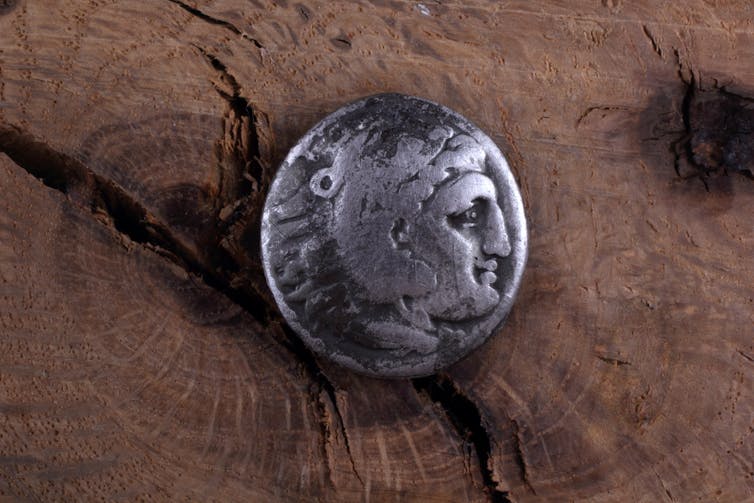
Alexandrou.
Alex Coan/Shutterstock.com
More than a thousand years after the invention of coinage, the Holy Roman Emperor Charlemagne (742-814), who ruled most of western and central Europe, developed what became the basis of the British pre-decimal money system: pounds, shillings and pence. Charlemagne set up a currency system based on 240 pennies minted from a pound of silver. The pennies became established as the denier in France, the pfennig in Germany, the dinero in Spain, the denari in Italy and the penny in Britain.
So the real story of money as coinage was not one of barterers and traders: it emerged instead from a long history of politics, war and conflict. Money was an active agent in state and empire building, not a passive representation of price in the market. Control of the money supply was a major power of rulers: a sovereign power. Money was created and spent into circulation by rulers either directly, like Alexander, or through taxation or seizure of private holdings of precious metal.
Nor was early money necessarily based on precious metal. In fact, precious metal was relatively useless for building empires, because it was in short supply. Even in the Roman era, base metal was used, and Charlemagne’s new money eventually became debased. In China, gold and silver did not feature and paper money was being used as early as the 9th century.
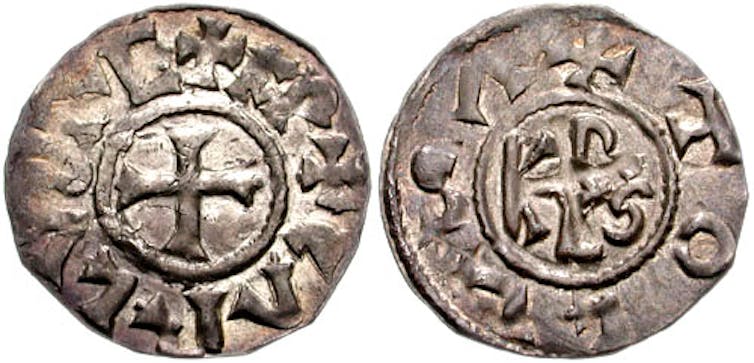
A coin from the time of Charlemagne, 768-814 AD.
Classical Numismatic Group, CC BY-SA
What the market economy did introduce was a new form of money: money as debt.
Money as debt
If you look at a £20 banknote you will see it says: “I promise to pay the bearer on demand the sum of twenty pounds.” This is a promise originally made by the Bank of England to exchange notes for the sovereign currency. The banknote was a new form of money. Unlike sovereign money it was not a statement of value, but a promise of value. A coin, even if made of base metal, was exchangeable in its own right: it did not represent another, superior, form of money. But when banknotes were first invented, they did.
The new invention of promissory notes emerged through the needs of trade in the 16th and 17th centuries. Promissory notes were used to acknowledge receipt of loans or investments and the obligation to repay them through the fruits of future transactions. A major task of the emerging profession of banking was to periodically set all these promises against each other and see who owed what to whom. This process of “clearing” meant that a great amount of paper commitments was reduced to relatively less actual transfer of money. Final settlement was either by payment with sovereign money (coins) or another promissory note (banknote).
Eventually, the banknotes became so trusted that they were treated as money in their own right. In Britain they became equivalent to the coinage, particularly when they were united under the banner of the Bank of England. Today, if you took a banknote to the Bank of England, it would merely exchange your note for one that is exactly the same. Banknotes are no longer promises, they are the currency. There is no other “real” money behind them.
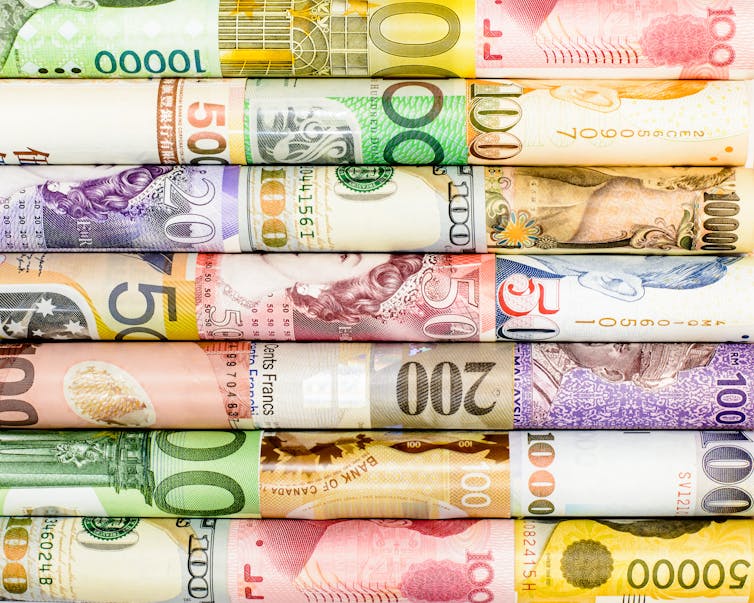
What promissory notes became.
Wara1982/Shutterstock.com
What modern money does retain is its association with debt. Unlike sovereign money, which was created and spent directly into circulation, modern money is largely borrowed into circulation through the banking system. This process shelters behind another myth, that banks merely act as a link between savers and borrowers. In fact, banks create money. And it is only in the last decade that this powerful myth has been finally put to rest by banking and monetary authorities.
It is now acknowledged by monetary authorities such as the IMF, the US Federal Reserve and the Bank of England, that banks are creating new money when they make loans. They don’t lend the money of other account holders to those who want to borrow.
Bank loans consist of money conjured out of thin air, whereby new money is credited to the borrowers account with the agreement that the amount will eventually be repaid with interest.
The policy implications of the public currency being created out of nowhere and lent to borrowers on a purely commercial basis have still not been taken on board. Nor has basing a public currency on debt as opposed to the sovereign power to create and directly circulate money free of debt.
The result is that rather than using their own sovereign power over money creation, as Alexander the Great did, states have become borrowers from the private sector. Where there are public spending deficits or the need for large scale future expenditure, there is an expectation that the state will borrow the money or increase taxation, rather than create the money itself.
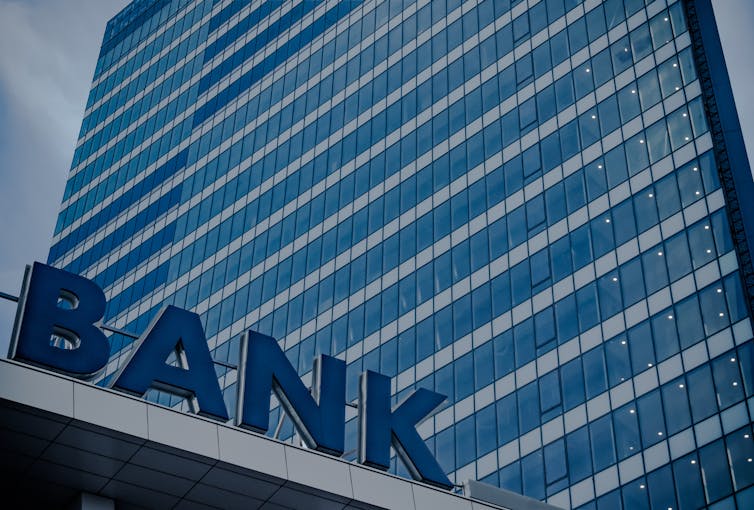
Creators of cash.
Creative Lab/Shutterstock.com
Dilemmas of debt
But basing a money supply on debt is ecologically, socially and economically problematic.
Ecologically, there is a problem because the need to pay off debt could drive potentially damaging growth: money creation based on repaying debt with interest must imply constant growth in the money supply. If this is achieved through increasing productive capacity, there will inevitably be pressure on natural resources.
Basing the money supply on debt is also socially discriminatory because not all citizens are in a position to take on debt. The pattern of the money supply will tend to favour the already rich or the most speculative risk-taker. Recent decades, for example, have seen a huge amount of borrowing by the financial sector to enhance their investments.
The economic problem is that the money supply depends on the capacity of the various elements of the economy (public and private) to take on more debt. And so as countries have become more dependent upon bank-created money, debt bubbles and credit crunches have become more frequent.
This is because handbag economics creates an impossible task for the private sector. It has to create all new money through bank-issued debt and repay it all with interest. It has to completely fund the public sector and generate a profit for investors.
But when the privatised bank-led money supply flounders, the money creating powers of the state come back into clear focus. This was particularly plain in the 2007-8 crisis, when central banks created new money in the process known as quantitative easing. Central banks used the sovereign power to create money free of debt to spend directly into the economy (by buying up existing government debt and other financial assets, for example).
The question then becomes: if the state as represented by the central bank can create money out of thin air to save the banks – why can’t it create money to save the people?
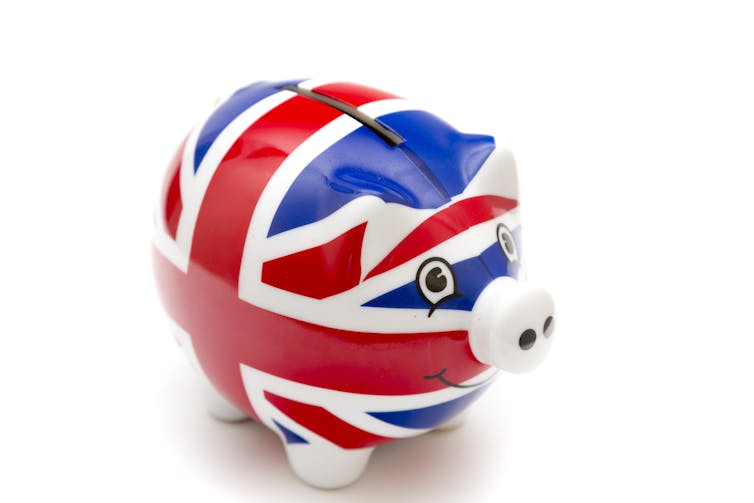
It’s a mistake to think of the state as a piggybank or handbag.
ColorMaker/Shutterstock.com
Money for the people
The myths about money have led us to look at public spending and taxation the wrong way around. Taxation and spending, like bank lending and repayment, is in a constant flow. Handbag economics assumes that it is taxation (of the private sector) that is raising the money to fund the public sector. That taxation takes money out of the taxpayer’s pocket.
But the long political history of sovereign power over money would indicate that the flow of money can be in the opposite direction. In the same way that banks can conjure money out of thin air to make loans, states can conjure money out of thin air to fund public spending. Banks create money by setting up bank accounts, states create money by allocating budgets.
When governments set budgets they do not see how much money they have in a pre-existing taxation piggybank. The budget allocates spending commitments that may, or may not, match the amount of money coming in through taxation. Through its accounts in the treasury and the central bank, the state is constantly spending out and taking in money. If it spends more money than it takes in, it leaves more money in people’s pockets. This creates a budget deficit and what is effectively an overdraft at the central bank.
Is this a problem? Yes, if the state is treated as if it was any other bank account holder – the dependent household of handbag economics. No, if it is seen as an independent source of money. States do not need to wait for handouts from the commercial sector. States are the authority behind the money system. The power exercised by the banks to create the public currency out of thin air is a sovereign power.
It is no longer necessary to mint coins like Alexander, money can be created by keystrokes. There is no reason why this should be monopolised by the banking sector to create new public money as debt. Deeming public spending as being equivalent to bank borrowing denies the public, the sovereign people in a democracy, the right to access its own money free of debt.

Money should be designed for the many, not the few.
Varavin88/Shutterstock.com
Redefining money
This foray into the historical and anthropological stories about money shows that long-held conceptions – that money emerged from a previous market economy based on barter, and that it was originally made from precious metal – are fairytales. We need to recognise this. And we need to capitalise on the public ability to create money.
But it is also important to recognise that the sovereign power to create money is not a solution in itself. Both the state and bank capacity to create money have advantages and disadvantages. Both can be abused. The reckless lending of the banking sector, for example, led to the near meltdown of the American and European monetary and financial system. On the other hand, where countries do not have a developed banking sector, the money supply remains in the hands of the state, with massive room for corruption and mismanagement.
The answer must be to subject both forms of money creation – bank and state – to democratic accountability. Far from being a technical, commercial instrument, money can be seen as a social and political construct that has immense radical potential. Our ability to harness this is hampered if we do not understand what money is and how it works. Money must become our servant, rather than our master.
Mary Mellor’s new book Money: Myths, Truths and Alternatives is published by Policy Press on July 3.
Mary Mellor, Emeritus Professor, Northumbria University, Newcastle
This article is republished from The Conversation under a Creative Commons license. Read the original article.
Комментариев нет:
Отправить комментарий